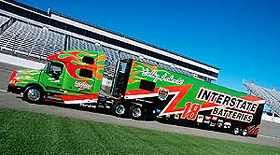Dumping Air On Cat Scales
Topic 18582 | Page 1
Aaron, I read your 'bad shippers' thread and found it very informative; thanks for going into greater detail here. You've helped at least one person prevent making the same mistake!
And here's another opportunity to thank Brett for creating this site and the moderators et al. for their sound advice and wisdom. I was wondering why Linden didn't give his two cents?

Shipper:
The customer who is shipping the freight. This is where the driver will pick up a load and then deliver it to the receiver or consignee.

I'm actually newer than new. I dont drive yet. So my question as stupid as I feel for asking. What did not setting your brakes have to do with your weight? Or was this just a run through of what you did. If so why didn't you set them?
I'm going to paste my entire last response to the other thread, for the technical explanation of why this happens. Just so it doesn't get lost in the other thread.
FYI - The supplies to all scales that weigh every axle simultaneously, not just Cat scales.
And Aaron's original post, dumping the air on the trailer suspension, cause the trailer to pull the fifth wheel and drives upwards, shifting additional weight onto the steers.
This one was a head scratcher. ----------------
When running an air suspension trailer - if you pop the trailer air, it dumps the suspension. When you dump the suspension, it pulls UP on the front of the trailer (depending on how much weight is loaded towards the rear), pulling UP on the kingpin, and causing it to PULL UP on the drives.
This shifts weight OFF the drives and ONTO THE STEERS.
Had a conversation with G-Town - because the entire scenario seemed weird, the way the weights were moving around in a weird fashion - especially with weight added to the steers in that fashion. We kicked this around a bit - and came to these conclusions.
I was looking at the "pure physics" of the equation - and just couldn't fathom why the weights shifted the way they did.
Figure the axle sets like pivot points on a see-saw. Then throw in what happens when you dump the airbags on the trailer and change the height of the pivot point (which is what happens when you set the trailer spring brakes by killing the supply air - which also supplies air to the suspension).
This makes an interesting lesson for EVERYONE (including me), especially on how to get accurate weights on a scale. Set the trailer brakes with the trolley/johnson bar. If you have to shut the motor off if you have to talk to the cashier, there's plenty of air left to keep the brakes applied while you weigh (remember the leakdown test). You should only set one set of brakes - in order to keep from "loading up" tension between the "braked" axle sets.
This was a cool issue to figure out. Didn't conform with the "average weights & balances" problem.
Still would have run with 100lbs over on the steers and burnt the fuel off. Would have loved to see what the "actual weights" were with the brakes set correctly.
Rick
CAT Scale:
A network of over 1,500 certified truck scales across the U.S. and Canada found primarily at truck stops. CAT scales are by far the most trustworthy scales out there.
In fact, CAT Scale offers an unconditional Guarantee:
“If you get an overweight fine from the state after our scale showed your legal, we will immediately check our scale. If our scale is wrong, we will reimburse you for the fine. If our scale is correct, a representative of CAT Scale Company will appear in court with the driver as a witness”
Cat Scales:
A network of over 1,500 certified truck scales across the U.S. and Canada found primarily at truck stops. CAT scales are by far the most trustworthy scales out there.
In fact, CAT Scale offers an unconditional Guarantee:
“If you get an overweight fine from the state after our scale showed your legal, we will immediately check our scale. If our scale is wrong, we will reimburse you for the fine. If our scale is correct, a representative of CAT Scale Company will appear in court with the driver as a witness”
I'm actually newer than new. I dont drive yet. So my question as stupid as I feel for asking. What did not setting your brakes have to do with your weight? Or was this just a run through of what you did. If so why didn't you set them?
Matt, Go back and read the entire "Bad Shipper?" thread
Shipper:
The customer who is shipping the freight. This is where the driver will pick up a load and then deliver it to the receiver or consignee.

Aaron,...buddy don't beat yourself up. You learned a valuable lesson and had the courage to share it. Props!
Having read the recent, accurate weight, you don't have enough weight on your steers. You want another 1200-1500 pounds on your steers. Find the sweet spot and never move the fifth wheel again. I'd move it at least 2, possibly 3 notches towards the cab. When loaded (40+k) and fuel is full, the steer axle weights won't fluctuate more than a couple hundred pounds.
Never ends...great job though. You truly care about being professional. Again Props!
Aaron,...buddy don't beat yourself up. You learned a valuable lesson and had the courage to share it. Props!
Having read the recent, accurate weight, you don't have enough weight on your steers. You want another 1200-1500 pounds on your steers. Find the sweet spot and never move the fifth wheel again. I'd move it at least 2, possibly 3 notches towards the cab. When loaded (40+k) and fuel is full, the steer axle weights won't fluctuate more than a couple hundred pounds.
Never ends...great job though. You truly care about being professional. Again Props!
Good catch there G-Town.
I neglected to consider, with the steers that light, his steering is going to be a tad light also.
We've heard of a number of companies here, that don't even allow you to move your fifth wheel. They are fixed in place.
Love this place. Keeps the old brain clicking.
Rick
Having read the recent, accurate weight, you don't have enough weight on your steers. You want another 1200-1500 pounds on your steers. Find the sweet spot and never move the fifth wheel again. I'd move it at least 2, possibly 3 notches towards the cab. When loaded (40+k) and fuel is full, the steer axle weights won't fluctuate more than a couple hundred pounds.
I am driving a 2015 Cascadia. Not looking at it right now, but I believe the front pins are in the 4th hole "notch" back from the cab. This setting has the 5th wheel centered between the drives. I am never over on my steers, even full of fuel, but always at least 11300. I never have to move it. Thanks again Aaron for your thoroughness in keeping this subject updated. A great lesson for all!


Wow I went back and read that. That is really good information. Hopefully more will read it so it doesn't get lost

Aaron,...buddy don't beat yourself up. You learned a valuable lesson and had the courage to share it. Props!
Having read the recent, accurate weight, you don't have enough weight on your steers. You want another 1200-1500 pounds on your steers. Find the sweet spot and never move the fifth wheel again. I'd move it at least 2, possibly 3 notches towards the cab. When loaded (40+k) and fuel is full, the steer axle weights won't fluctuate more than a couple hundred pounds.
Never ends...great job though. You truly care about being professional. Again Props!
Good catch there G-Town.
I neglected to consider, with the steers that light, his steering is going to be a tad light also.
We've heard of a number of companies here, that don't even allow you to move your fifth wheel. They are fixed in place.
Love this place. Keeps the old brain clicking.
Rick
Thanks Rick. Funny how this went completely "full-circle" from where it started.
The physical properties of weight is a powerful force and the basics must be understood and respected at all times. Weight balance on a loaded truck is the key and I am a total stickler for it. I have flagged newbie drivers down at the DC because I can see their weights on an illuminated sign if I am in the scale line behind them. Huge in-balance or overweight on an axle and I will try to stop them before they leave the safety of the DC. I saw a guy last week who had 11,200 on the steers, 28,400 on the drives, and 34,900 on the tandems. It was a weekday, if he was headed to Jersey, one of the scales would have nabbed him (likely in Alpha on I-78). Fortunately he pulled ahead, stopped and reset his tandems before he left...not always the case though.
Running a truck with a huge weight in-balance between the drive axle-set and tandems is not only potentially unsafe, makes for a really poor ride, but it's extremely inefficient as well. Unfortunately one of the common rookie mistakes I see everyday involves this very subject. There seems to be a tendency to run in the one to four hole setting, tandems tucked up under the trailer causing a tremendous overhang in the rear but with the perception of easier maneuverability (cornering and backing). Keep in mind that in many states (like CT and MD) DOT will measure the overhang and write a citation if it's excessive, over 14'. If the trailer is cubed-out, meaning freight is occupying space from nose to tail, there is a potential for many thousands of pounds behind the tandems, pushing on the pivot point of the tandem , causing the nose of the trailer to pull-up on the kingpin/fifth-wheel. When running like this every bump and dip in the road will make for a very bouncy and overall exhausting ride. A roller-coaster affect. Balance...! The only time I run in the 6 hole is with water loads because the weight occupies only 44' of floor space (21-22 pallets). For this, in the 6 hole there is no weight behind the tandems, so the ride is smooth, level and most important legal. The devil is in the details, and achieving weight balance is one of them.
Aaron's final and accurate weigh was okay, except for the lack of weight on the steers. Keep in mind, moving the fifth wheel will move the weight off the drives and onto the steers, possibly requiring another adjustment to the tandems to achieve balance (sliding one hole or two to the rear of the trailer). Again thanks to Aaron for posting the original problem, interesting. If you are still out there Aaron, stop back for a visit.
Tandems:
Tandem Axles
A set of axles spaced close together, legally defined as more than 40 and less than 96 inches apart by the USDOT. Drivers tend to refer to the tandem axles on their trailer as just "tandems". You might hear a driver say, "I'm 400 pounds overweight on my tandems", referring to his trailer tandems, not his tractor tandems. Tractor tandems are generally just referred to as "drives" which is short for "drive axles".
Tandem:
Tandem Axles
A set of axles spaced close together, legally defined as more than 40 and less than 96 inches apart by the USDOT. Drivers tend to refer to the tandem axles on their trailer as just "tandems". You might hear a driver say, "I'm 400 pounds overweight on my tandems", referring to his trailer tandems, not his tractor tandems. Tractor tandems are generally just referred to as "drives" which is short for "drive axles".
DOT:
Department Of Transportation
A department of the federal executive branch responsible for the national highways and for railroad and airline safety. It also manages Amtrak, the national railroad system, and the Coast Guard.
State and Federal DOT Officers are responsible for commercial vehicle enforcement. "The truck police" you could call them.
New Reply:
New! Check out our help videos for a better understanding of our forum features

















Preview:








 TT On Facebook
TT On Facebook
To be clear, I work with swift, with only 5 months driving experience. I knows nothing. Plus I am not entirely sure about this so I can't say for certain this works in ALL states with ALL loads and ALL trucks. This is basically just a very small idea from a rookie.
It never occured to me until I made a thread called "bad shippers" that when dumping air on the tractor and trailer you "add" about 1500 to 2000 lbs on your steers.
I went back to the shipper twice to have my load reworked thinking the shipper was the problem (hence why I titled it bad shipper), when in reality it was me being a complete noob.
After the rework and getting scaled here were my weights:
Steer 12460 Drives 28660 Trailer 33600 Gross 74720
I had half a tank of fuel, no apu , 5th wheel all the way back, and tandoms where they need to be. As u can see I was 460lbs over on steers and I was heading into indiana and they are 12000 on steers.
Realizing my mistake, I went back to a truck stop and I DID NOT set my brakes and here are the new weights without me adjusting anything:
10300 31800 32440 74540
I kept the truck in gear, brakes released and shut off the truck so I can hear the cashier through the intercom. I didn't use the johnson bar but i did keep my foot on the brake.
I drove into indiana, and was able to bypass their weigh station. I am now in illinois. Im good haha.
I wasted a lot of time (and $$$$) doing this where if I'd know I could have had this load dropped 2 days ago.
Hopefully the next driver won't make this extreme rookie mistake.
Shipper:
The customer who is shipping the freight. This is where the driver will pick up a load and then deliver it to the receiver or consignee.
TWIC:
Transportation Worker Identification Credential
Truck drivers who regularly pick up from or deliver to the shipping ports will often be required to carry a TWIC card.
Your TWIC is a tamper-resistant biometric card which acts as both your identification in secure areas, as well as an indicator of you having passed the necessary security clearance. TWIC cards are valid for five years. The issuance of TWIC cards is overseen by the Transportation Security Administration and the Department of Homeland Security.
APU:
Auxiliary Power Unit
On tractor trailers, and APU is a small diesel engine that powers a heat and air conditioning unit while charging the truck's main batteries at the same time. This allows the driver to remain comfortable in the cab and have access to electric power without running the main truck engine.
Having an APU helps save money in fuel costs and saves wear and tear on the main engine, though they tend to be expensive to install and maintain. Therefore only a very small percentage of the trucks on the road today come equipped with an APU.